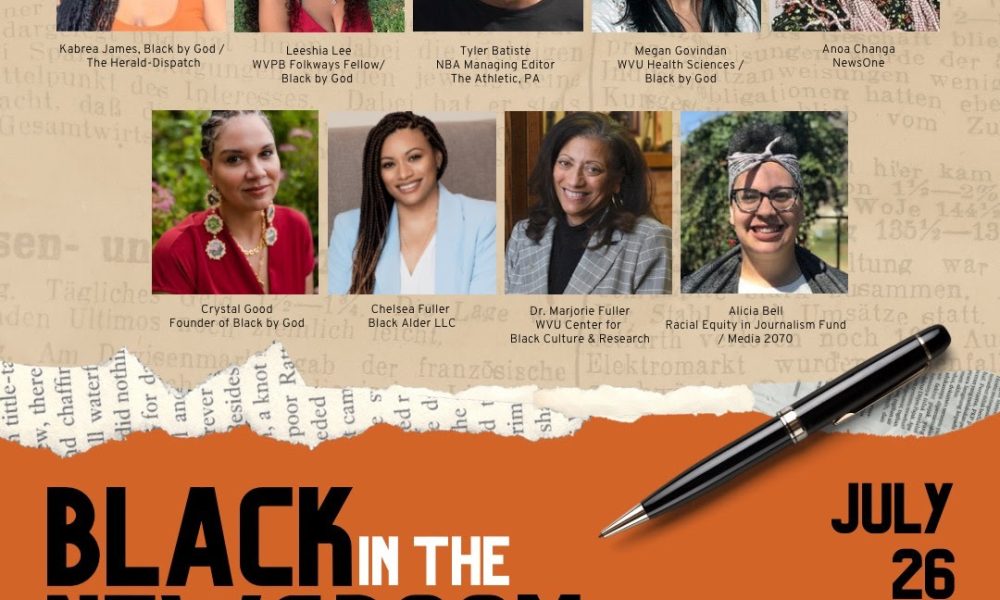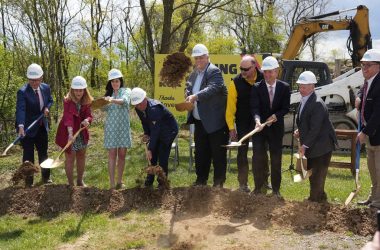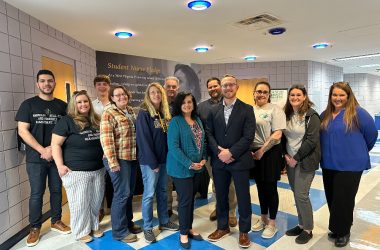Documentary showing at 4 p.m. at Vantage Ventures in Morgantown
WV Press Release Sharing
MORGANTOWN, W.Va. — The new documentary short film “Black in the Newsroom” will have a free screened today at 4 p.m. at Vantage Ventures in Morgantown
Black by God, Vantage Ventures, Media 2070, The Diversity Pledge Institute, WVU Reed College of Media – NewStart Program, WVU Center for Black Culture and Research, WVU Health Affairs, The Diversity Pledge Institute and 100 Days of Appalachia, are sponsoring a screening of the new documentary “Black in the Newsroom” at Vantage Ventures. The screening will be followed by a conversation with journalists of color, moderated by Dr. Majorie Fuller from West Virginia University.
Organizers of the screening said the short film sheds light on systemic failures of print media in hiring, promoting and nurturing Black journalistic talent.
100 Days in Appalachia and our other partners, Black By God is sponsoring a screening of the new documentary “Black in the Newsroom” tonight at Vantage Ventures in Morgantown, West Virginia.
Crystal Good is a poet, a performer and the founder of Black By God – The West Virginian. The first and only newspaper by and for Black West Virginians since the 1990s, Black By God platforms voices from across the state which are not always heard or considered by mainstream news organizations. In framing stories with Black readers specifically in mind, Good hopes to provide Black West Virginians with a newspaper catering to their interests and needs – something few if any other newspapers in the state are doing well, if at all. She will also be part of a panel discussion following the film.
Skylar Baker-Jordan of 100 Days in Appalachia spoke with Good about the film and tonight’s screening. What follows is a transcript of our conversation, lightly edited for length and clarity.
Skylar Baker-Jordan: You founded Black By God – The West Virginian, which is the only newspaper in West Virginia run by and for people of color. What has the reaction been at home?
Crystal Good: The reaction has been amazing. So, from the very first issue it created a great momentum, one because even though we had been doing a newsletter for a year prior to the print launch – and we just celebrated the print’s one year anniversary. That’s about two years of tinkering with Black By God.
When I decided to do the print, that’s when it became real. It’s COVID. It’s the middle of 2020. The reality of racism in America and all the arrests, and it’s a Black newspaper in West Virginia for, by, and to Black people. The print made things real. It made things real because it was tactile in the time of COVID, when we were all just overwhelmed with our screen time and a lack of connection, but also it was a reflection of Black joy. Of Black success.
Also articles that articulate a lot of things that don’t always get said in mainstream papers. When you think of mainstream papers, they use words like “underserved communities” and blah blah blah. And basically, what you’re talking about is just “not white people.” Being the Black press, we can frame things in a language that doesn’t have to dance around things. I hope we are doing that and being direct and truthful, that we can say things that are valid and truthful with journalism and integrity and all that detail. But it’s also in the framing of things.
So the first issue showed that journalism could be different. And also, that this is not a new thing. Black newspapers have been in West Virginia since the 1800s. I’m just picking up the tradition and the mantle… Black By God is creating a record for somebody to find that says, “We were here.”
SBJ: A recent Pew study of journalists across America found that more than half of the nation’s journalists do not believe their newsrooms have enough racial and ethnic diversity. That same study found only 5% of journalists are Black. Why is journalism so lily white?
CG: If you go look up Media 2070, you can read their white paper about media reparations, and they will take you back to why. They will take you back to how all of our nation’s legacy papers’ roots are in making money off of enslaved humans by promoting these ads. We know humans were bought and sold, and they were bought and sold at a certain time in a certain place. They were often advertised in many of our legacy papers. So, you gotta go all the way back.
SBJ: Black journalists were more likely to report their newsrooms did not treat everyone fairly and were more likely to report harassment from people outside the organization. How can we make white powerbrokers like senior reporters and editors see these problems, and how can we fix them?
CG: The opportunity may not be in shifting these legacy papers. One thing I know is you can’t just put a Black person in a newsroom, and it all works out. My great grandmother was a typesetter in Ohio. So, I’m thinking of my great-grandmother being a typesetter, literally taking little letters and placing them to make a headline. And here I am, I can publish a newspaper on my computer with a click. So,what wasn’t possible in media 10, 20, 50 years ago and where we are today – it’s a shift. That lends itself to us rethinking about how it’s not about how we change these legacy papers.
SBJ: If you could do one thing to make American newsrooms better for people of color who work in them, what would it be?
CG: I think it’s a complete change, as opposed to restructuring the newsrooms to make them accommodating. It’s rethinking the newsroom in general. We’re at a building phase. I’m not afraid of imagination, and a lot of people are. It’s important to know your past but it’s important to imagine a future… I think we need to reimagine everything. What does community journalism look like? I think the newsrooms of the future will look different than the ones we have today.
SBJ: What advice would you give to aspiring journalists of color?
CG: Write for me! How can I help? Black By God is a place you can publish and submit to and get started. And also, I need to learn from people who are interested in this profession or writing. What do you need? How can I help besides just creating a platform? One thing that surprised me about publishing is how much one-on-one talk time it takes.
SBJ: What do you hope people take away from the documentary “Black in the Newsroom” and the conversation with journalists of color you’re hosting after the screening?
CG: I am very intentional. I want community to happen. I want folks from the Black By God team coming to meet the Black journalists out in the field so that they feel connected and that they have relationships, “big brothers” and “big sisters” out there. I think in West Virginia, having such a small population, having no other “Black news reporters” to network with in the state, sometimes you feel very vulnerable, and you don’t want to make a lot of noise. And maybe you have a real concern about a story or something someone said to you, and you don’t really have anywhere to take that. I’m hoping that those connections will be made so we’re creating visibility. We’re creating community. We’re creating network.
It is also about creating accountability. Once you start talking about something, people start looking around and maybe start asking questions. How many Black professors do we have at West Virginia University or Marshall who are teaching journalism or communications? How many Black reporters do we have anywhere? And how can we encourage people to become storytellers?






